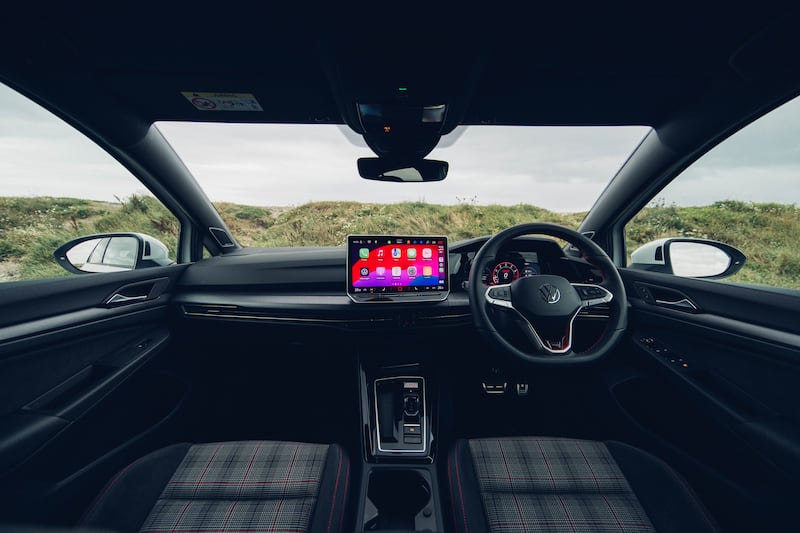When the history books look back on the fossil fuel motoring age, there’s sure to be a chapter on the hot hatches. And pride of place will be garnered by the Volkswagen (VW) Golf GTi. There were a few others who can claim rights on the hot hatch moniker, but it was the Germans who made it mainstream.
Now in the middle of its eighth generation, the Germans have tweaked and meddled with it over the decades, but from the first generation, the basic recipe was right. Take the functional Golf and add more fun.
The Mark 1 in 1976 got the mix right. Through the following generations engineers tinkered for good or ill.
Recently the GTi suffered the same flawed infotainment user experience as the rest of the Volkswagen range, while attempts to make it more aggressively sporty by stiffening the suspension ultimately upset the car’s balance and poise.
The hot hatch rules are simple: turn the dial too much to performance and you upset the everyday comfort; soften it too much and you lose the fun. Get it right and you have the Goldilocks GTi.

Aesthetically, little has been changed in this mid-life update. There are revamps to the LED light clusters front and rear, while inside there’s the 12.9-inch touchscreen from the facelifted Golf range with the improved operating system. And there are several discrete upgrades to elements of the interior trim that add up to a quality improvement. And they’ve retained the trademark tartan seating. But no one buys a GTi for the interior trim.

It’s that mix of practical performance that’s the lure. VW has squeezed an extra 20hp from the 2-litre petrol engine, bringing total output for the “regular” GTi to 262bhp. Admittedly, the days of conducting its output through the manual gearbox are over – the GTi only comes with auto seven-speed DSG – but while the traditionalists may complain about the lack of a short-throw gear stick, this dual-clutch auto set-up is smooth and responsive.
Our test car came with the optional Dynamic Chassis Control (DCC) set-up, which adapts the suspension to suit the various driving modes. In practical terms, in Normal mode the GTi is better at cosseting you from the rough and tumble of west of Ireland back roads. Stick it into Sport mode and the car stiffens significantly, making the car feel a lot more direct and engaging.


Currently priced at €1,105, DCC is an option worth the spend for it delivers the breadth of driving range the GTi is supposed to epitomise: a car that can range from comfortable for the commute to agile and engaging when the need arises.
In many ways, that’s the beauty of modern tech: it can widen the bandwidth of how you can change the driving characteristics of a car without need for a mechanic and a lift.
Yet, tech is also the elephant in the room for hot hatches. In straight-line performance, EVs will deliver the sort of pace that these turbocharged combustion models can’t match. So on paper, if performance is your preference, you’ll turn to electric every time.

That’s why, for a time, VW was prepared to scrap the GTi (and Golf) brands in favour of GTX electric cars. Thankfully, when Thomas Schafer became chief executive in 2022, such automotive sacrilege has been shelved.
And currently there remains a case for this petrol-powered hot hatch. Firstly, there is the obvious heritage. Never dismiss the power of nostalgia to protect a car’s resale value.
Next there is the linear delivery of power: in many cases floor an EV and the performance is frantic – and frankly uncomfortable – compared to the pacy but gradual pitch of a petrol equivalent.
Finally, there is poise: for now, the heavy battery packs affixed to the chassis impacts on the agility of many EVs.

Of course, that’s not going to remain the case for long. Take a drive in Hyundai’s Ioniq 5 N and you’ll encounter an EV that’s already broaching the sort of balanced set-up and cornering prowess associated with regular hot hatches.
And then there’s the price. An on-the-road price of €59,560 means it’s hardly the affordable upgrade for the average family car buyer whose also loves to drive. The beauty of the original hot hatch ethos was that car fans could step up to the likes of GTi if they were prepared to forgo other financial outlays. These days you are looking at a €15,000 to €20,000 price jump from the regular petrol or diesel Golf.
On a more positive note, even criss-crossing the country, I was managing to deliver a steady average of 6.8 l/100km, or just under 40mpg in old money.
For someone who grew up at the height of the hot hatch era, there is no escaping the evocative nature of the Golf GTi. But even for those who don’t carry those memories or associations, the ethos of the Golf GTi is as apt today as it was in the late 1970s.
Practicality with performance is something to which every mainstream car engineer should aspire. And getting that mix right can prove tricky, as demonstrated by multiple SUVs and surging EVs on the market right now.
Even VW hasn’t always got the recipe right over the GTi’s eight generations. Thankfully, with this latest iteration, they’ve cooked up a cracking good car.
Lowdown: VW Golf GTi
Power: 1,984 trubocharged petrol engine with seven-speed dual-clutch auto transmission, putting out 265hp (195kW) and delivering 370Nm of max torque
0-100km/h: 5.9 secs
Emissions (motor tax): 162-166g/km (€420)
Fuel consumption: 7.1-7.3l/100km (WLTP)
Price: €63,222 as tested. Starts at €59,560 on the road
Our rating: 4/5
Verdict: Nearly 50 years on, VW still has the hot hatch recipe right with the GTi













